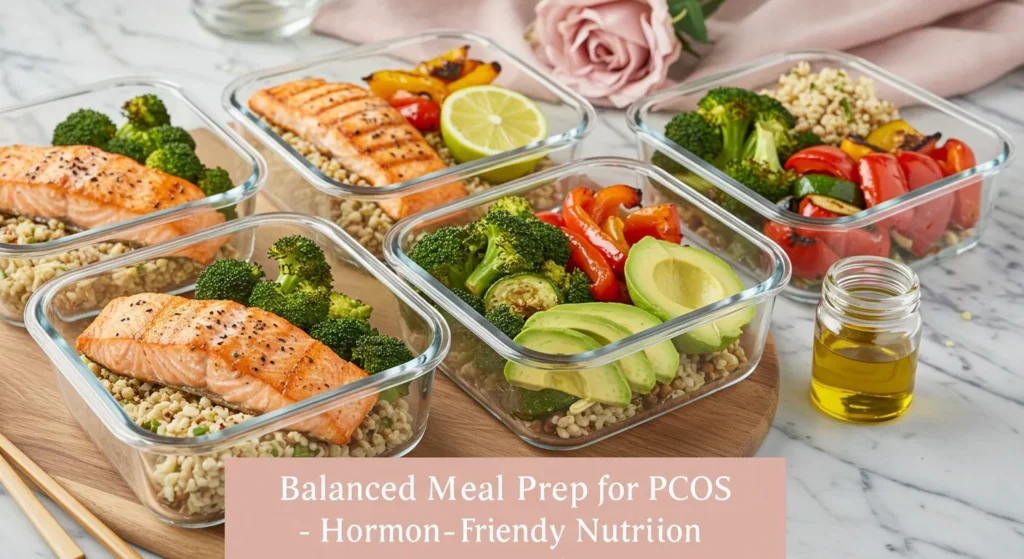
Table of Contents
Introduction
Polycystic Ovary Syndrome (PCOS) affects approximately 8-13% of women of reproductive age worldwide, making it one of the most common endocrine disorders among women. This complex condition is characterized by hormonal imbalances, insulin resistance, and often weight management challenges. While there is no cure for PCOS PCOS Women , nutrition plays a crucial role in managing symptoms and improving overall health outcomes.
Meal preparation (meal prep) is a strategic approach to food planning and preparation that can be particularly beneficial for women with PCOS. By dedicating time to plan, prepare, and portion meals in advance, women with PCOS can maintain consistent eating patterns, control ingredients, and make healthier food choices even during busy periods. This comprehensive guide explores how effective meal prep can help manage PCOS symptoms, outlines PCOS-friendly meal preparation strategies, and provides practical recipes and tips to incorporate into your weekly routine.
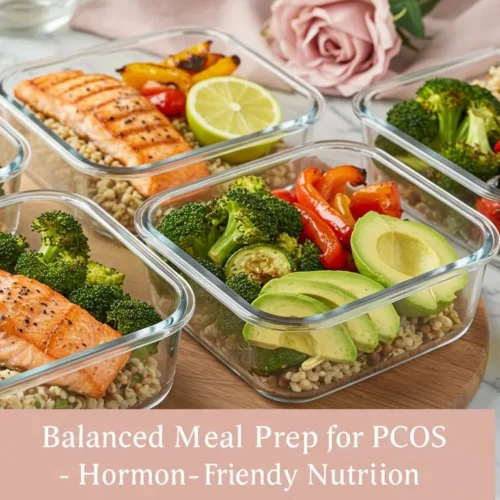
PCOS-Friendly Meal Prep Plan
Ingredients
- Lean proteins chicken, turkey, fish, tofu, tempeh
- Complex carbohydrates quinoa, brown rice, sweet potatoes
- Healthy fats olive oil, avocados, nuts, seeds
- Non-starchy vegetables broccoli, cauliflower, leafy greens
- Anti-inflammatory spices turmeric, ginger, cinnamon
- Low-glycemic fruits berries, apples
Understanding PCOS and Nutrition Connection
Before diving into meal prep strategies, it’s important to understand how nutrition impacts PCOS symptoms. PCOS typically presents with:
- Insulin Resistance: Up to 70% of women with PCOS experience insulin resistance, where the body’s cells don’t respond effectively to insulin, leading to higher blood sugar levels and increased insulin production.
- Hormonal Imbalances: Elevated androgen (male hormone) levels can cause symptoms like irregular periods, acne, and excess hair growth.
- Chronic Inflammation: Many women with PCOS show higher markers of inflammation, which can worsen insulin resistance and other symptoms.
- Weight Management Challenges: PCOS can make weight loss more difficult due to metabolic changes.
Diet modifications that focus on regulating blood sugar, reducing inflammation, and supporting hormonal balance can help manage these symptoms. This is where strategic meal prep becomes invaluable.
Benefits of Meal Prep for PCOS Management
Meal prepping offers numerous advantages for women with PCOS:
- Blood Sugar Stabilization: Eating regularly timed, balanced meals helps maintain stable blood sugar levels, reducing insulin spikes that can exacerbate PCOS symptoms.
- Portion Control: Pre-portioned meals prevent overeating and support weight management goals.
- Reduced Food Temptations: Having healthy options ready decreases the likelihood of choosing processed foods during busy or stressful times.
- Consistent Nutrition: Ensures regular intake of nutrients that support hormonal health.
- Time and Cost Efficiency: Reduces the time spent daily on food preparation and can lower grocery expenses through bulk purchasing and reduced food waste.
- Stress Reduction: Eliminates daily decisions about what to eat, reducing stress which can worsen PCOS symptoms.
PCOS-Friendly Nutrition Principles
Effective meal prep for PCOS should incorporate these key nutritional principles:
Balance Macronutrients
Each meal should include:
- Protein (25-30% of plate): Lean animal proteins or plant-based options help control hunger, stabilize blood sugar, and support muscle maintenance.
- Complex Carbohydrates (30-40% of plate): Focus on fiber-rich, low-glycemic carbs that digest slowly and prevent blood sugar spikes.
- Healthy Fats (20-35% of plate): Essential for hormone production and absorption of fat-soluble vitamins.
- Non-starchy Vegetables (at least half the plate): Provide essential nutrients and fiber with minimal impact on blood sugar.
Anti-Inflammatory Focus
Prioritize foods that reduce inflammation:
- Fatty fish rich in omega-3s (salmon, mackerel, sardines)
- Colorful fruits and vegetables (berries, leafy greens, peppers)
- Nuts and seeds (walnuts, flaxseeds, chia seeds)
- Olive oil and avocados
- Spices like turmeric, ginger, and cinnamon
Low-Glycemic Approach
Choose carbohydrates that have minimal impact on blood sugar:
- Non-starchy vegetables: Broccoli, cauliflower, zucchini, spinach
- Whole intact grains: Quinoa, brown rice, farro, barley
- Legumes: Lentils, chickpeas, black beans
- Low-sugar fruits: Berries, apples, pears
Foods to Limit
For optimal PCOS management, reduce consumption of:
- Refined carbohydrates and sugars: White bread, pastries, sodas, fruit juices
- Processed foods: Packaged snacks, frozen meals, processed meats
- Trans fats: Fried foods and many baked goods
- Excessive caffeine and alcohol: Can disrupt hormone balance and sleep
- Dairy (for some women): May trigger inflammation in sensitive individuals
Essential Meal Prep Equipment
Setting up for successful meal prep requires some basic equipment:
- Quality food storage containers: BPA-free glass or silicone containers in various sizes
- Meal prep containers with compartments: For portioning different food groups
- Sheet pans: For roasting vegetables and proteins
- Slow cooker or Instant Pot: For hands-off cooking of proteins and stews
- Food scale: For portion control
- Sharp knives and cutting boards: For efficient food preparation
- Blender or food processor: For smoothies, sauces, and dressings
- Reusable bags: For storing prepped ingredients and snacks
Weekly Meal Prep Strategy for PCOS
Step 1: Planning (1-2 hours)
- Set aside dedicated planning time each week (e.g., Thursday evening)
- Create a meal template with breakfast, lunch, dinner, and snacks for all days
- Check your schedule to account for meals away from home
- Take inventory of what you already have
- Make a detailed shopping list organized by store sections
- Consider batch cooking recipes that can be repurposed throughout the week
Step 2: Shopping (1-2 hours)
- Shop with a full stomach to avoid impulse purchases
- Stick to your list and focus on whole foods from the perimeter of the store
- Read labels carefully to avoid hidden sugars and inflammatory ingredients
- Consider local farmers’ markets for fresher produce options
- Buy in bulk when appropriate for budget-friendly meal prep
Step 3: Preparation (2-4 hours)
- Set aside a dedicated prep day (typically Sunday or another less busy day)
- Start with time-intensive items like roasting vegetables or cooking whole grains
- Multi-task by using different appliances simultaneously (e.g., oven, stovetop, slow cooker)
- Wash and chop all produce for the week
- Cook proteins in batches
- Prepare dressings and sauces separately
- Assemble meals in appropriate containers
- Label everything with contents and date prepared
7-Day PCOS-Friendly Meal Prep Plan
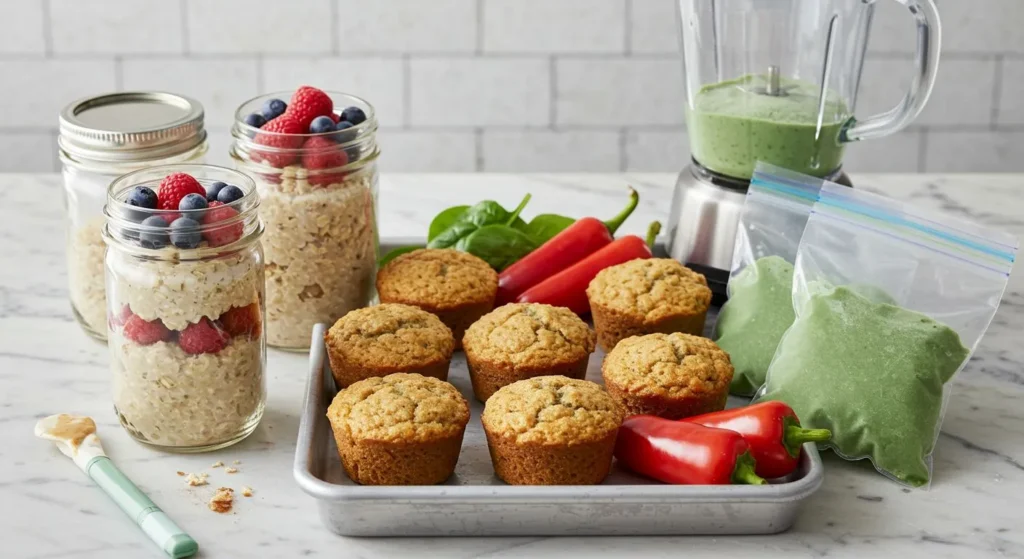
Breakfast Options (Prepare 2-3 in advance)
- Protein-Packed Overnight Oats
- ½ cup rolled oats
- 1 tablespoon chia seeds
- 1 scoop protein powder
- ¾ cup unsweetened almond milk
- ¼ cup berries
- 1 tablespoon almond butter
- Cinnamon to taste
- Prep 3-4 at once in mason jars
- Veggie Egg Muffins
- 12 eggs
- Chopped vegetables (spinach, bell peppers, onions)
- ¼ cup grated cheese (optional)
- Herbs and spices to taste
- Bake in muffin tins, store 2-3 per container
- Green Smoothie Freezer Packs
- 1 cup spinach
- ½ banana
- ¼ avocado
- 1 tablespoon ground flaxseed
- 1-inch ginger piece
- Portion ingredients in freezer bags, blend with protein powder and liquid when ready
Lunch Options (Prepare 4-5 in advance)
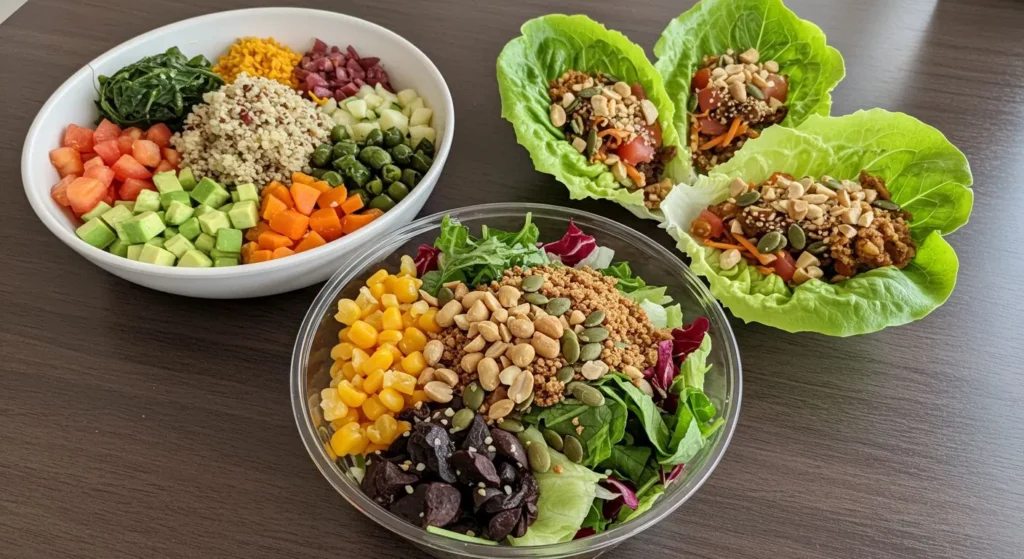
- Mediterranean Quinoa Bowls
- ½ cup cooked quinoa
- 4 oz grilled chicken or chickpeas
- ¼ cup cucumber, chopped
- ¼ cup cherry tomatoes, halved
- ¼ cup roasted red peppers
- 2 tablespoons olives
- 1 tablespoon feta cheese (optional)
- Lemon-olive oil dressing on the side
- Asian-Inspired Lettuce Wraps
- Large romaine or butter lettuce leaves
- 4 oz ground turkey or tempeh cooked with ginger, garlic, and coconut aminos
- Shredded carrots, cabbage, and bell peppers
- Chopped peanuts for garnish
- Tahini-lime dressing on the side
- Protein Power Salad
- 2 cups mixed greens
- 4 oz baked salmon or lentils
- ¼ cup roasted sweet potatoes
- ¼ avocado, sliced
- 1 tablespoon pumpkin seeds
- Balsamic vinaigrette on the side
Dinner Options (Prepare 3-4 in advance)
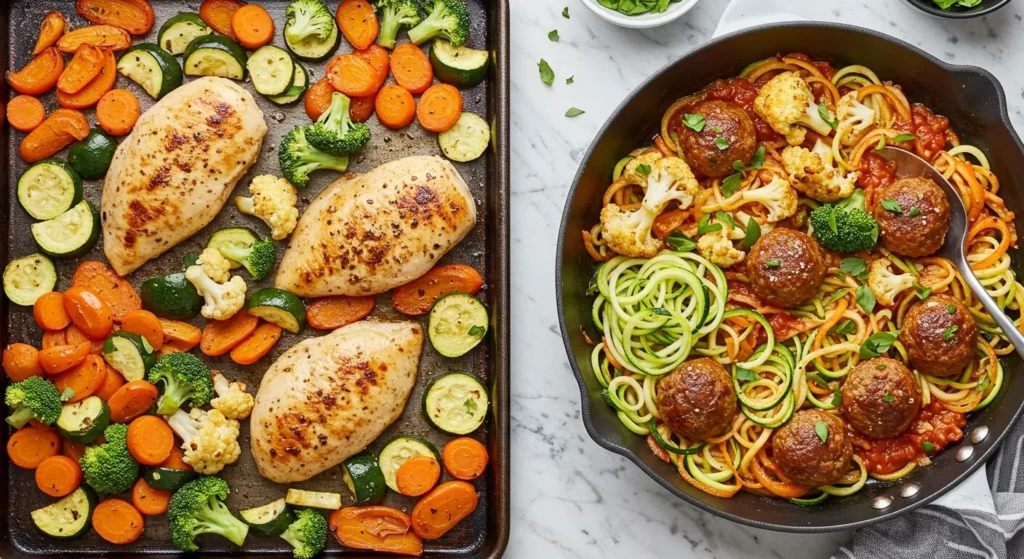
- Sheet Pan Protein & Vegetables
- 4 oz protein (chicken, fish, tofu)
- 1 cup roasted non-starchy vegetables (Brussels sprouts, broccoli, cauliflower)
- ¼ cup roasted sweet potato or butternut squash
- Herbs and spices of choice
- 1 tablespoon olive oil drizzle
- Cauliflower Rice Stir-Fry
- 1 cup cauliflower rice
- 4 oz protein of choice
- 1 cup mixed vegetables (snap peas, bell peppers, mushrooms)
- Ginger-garlic sauce with coconut aminos
- 1 tablespoon cashews for garnish
- Zucchini Noodles with Turkey Meatballs
- 2 cups zucchini noodles
- 4 oz turkey meatballs (prepared with almond flour instead of breadcrumbs)
- ½ cup sugar-free marinara sauce
- 1 tablespoon nutritional yeast or Parmesan
Snack Options (Prepare in bulk)

- Protein Energy Balls
- 1 cup almond flour
- ½ cup sugar-free nut butter
- ¼ cup ground flaxseed
- 2 scoops protein powder
- Cinnamon and vanilla extract
- Water as needed for consistency
- Veggie Sticks with Dip
- Cut carrots, celery, cucumber, bell peppers
- Pair with guacamole, hummus, or Greek yogurt dip
- Anti-Inflammatory Trail Mix
- Raw almonds
- Walnuts
- Pumpkin seeds
- Unsweetened coconut flakes
- Small amount of dark chocolate chips (85%+ cacao)
Sample Meal Prep Schedule
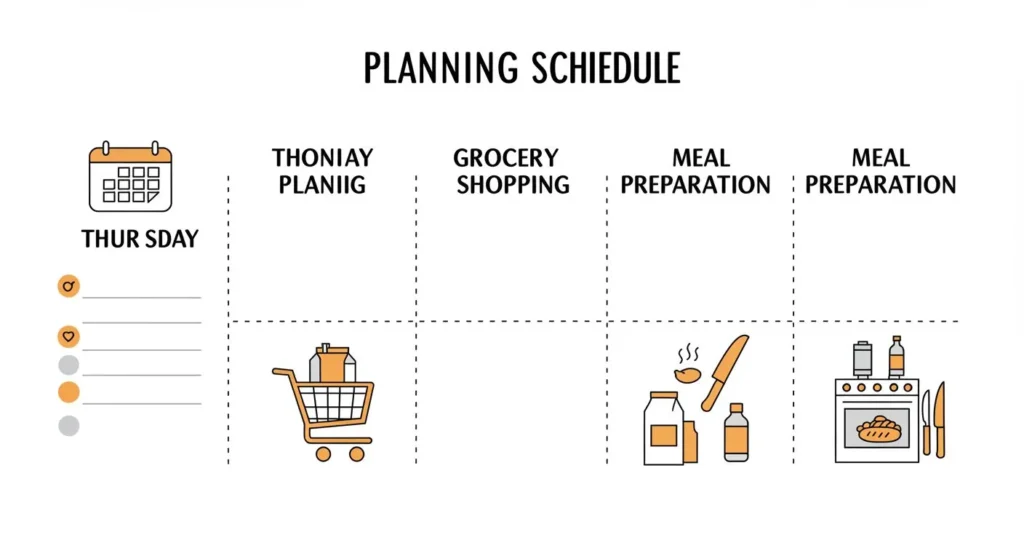
Thursday Evening
- Plan meals for the coming week
- Take inventory of pantry staples
- Create shopping list
Friday or Saturday
- Grocery shopping
- Organize ingredients
Sunday Prep Day
- Morning (2 hours):
- Roast multiple sheet pans of vegetables
- Cook grains (quinoa, brown rice)
- Bake proteins (chicken breasts, fish)
- Prepare egg muffins for breakfast
- Afternoon (1-2 hours):
- Chop raw vegetables for snacks and quick-cooking
- Make dressings and sauces
- Prepare energy balls or other snacks
- Assemble meals in containers
Midweek Mini-Prep (30 minutes)
- Wednesday evening: Quick refresh of any vegetables getting soft
- Prepare any additional items needed for the second half of the week
Tips for Successful PCOS Meal Prep
- Start small: Begin with prepping just breakfasts or lunches before tackling a full week
- Use the “cook once, eat twice” approach: Make extra dinner to repurpose for lunch
- Keep it interesting: Vary spices, herbs, and sauces to prevent meal fatigue
- Consider your schedule: Prep more complex meals for busy days
- Practice portion awareness: Use measured containers to avoid overeating
- Stay flexible: Have backup options for unexpected schedule changes
- Rotate proteins and vegetables: For nutritional variety and interest
- Involve family members: Make it a group activity
- Invest in quality storage: Proper containers extend freshness
- Monitor how you feel: Adjust meal compositions based on energy levels and symptoms
Managing Common PCOS Symptoms Through Meal Prep
For Insulin Resistance
- Prioritize protein at the start of meals
- Include fiber with every meal
- Add cinnamon to breakfast options
- Include apple cider vinegar in dressings
- Keep meals evenly spaced throughout the day
For Inflammation
- Incorporate turmeric, ginger, and other anti-inflammatory spices
- Include fatty fish at least twice weekly
- Focus on omega-3 rich foods
- Minimize refined oils and processed foods
- Include colorful vegetables at every meal
For Energy Management
- Balance complex carbs throughout the day
- Include protein with every meal and snack
- Prepare smaller, more frequent meals if needed
- Include iron-rich foods like spinach and lentils
- Stay hydrated with prepped infused waters
For Cravings
- Prepare emergency snack boxes with protein and healthy fats
- Include sweet alternatives like cinnamon-spiced apples or cacao-based treats
- Keep savory options available (olives, nuts, seaweed snacks)
- Pre-portion treat foods to prevent overconsumption
Seasonal Meal Prep Adjustments for PCOS
Spring/Summer
- Focus on lighter cooking methods (grilling, steaming)
- Incorporate seasonal berries and stone fruits in moderation
- Prepare chilled protein options (cold salmon, shrimp)
- Make use of fresh herbs
- Prepare hydrating foods with high water content
Fall/Winter
- Utilize warming spices (cinnamon, cloves, turmeric)
- Prepare hearty soups and stews in batches
- Roast seasonal root vegetables
- Include more warming beverages in your prep
- Focus on immune-supporting ingredients
Troubleshooting Common Meal Prep Challenges
Challenge: Food getting soggy
Solution: Store wet ingredients separately, use compartmentalized containers, add dressings just before eating
Challenge: Meal fatigue
Solution: Create a rotating meal schedule, use different spice blends, repurpose ingredients in different ways
Challenge: Not enough time
Solution: Start with partial prep (just chopping vegetables or cooking proteins), utilize time-saving appliances, break prep into smaller sessions
Challenge: Limited storage space
Solution: Use stackable containers, freeze portions, focus on ingredients that can be used multiple ways
Challenge: Family members with different needs
Solution: Prepare versatile base ingredients that can be customized, create a mix-and-match system
Conclusion
Meal preparation is a powerful strategy for women managing PCOS. By dedicating time to planning and preparing balanced, nutrient-dense meals, you can better control blood sugar levels, reduce inflammation, manage weight, and alleviate many PCOS symptoms. While it requires initial time investment, the benefits to hormonal health, energy levels, and overall well-being make it worthwhile.
Remember that consistency matters more than perfection. Start with small, manageable steps and gradually build your meal prep routine. Over time, you’ll discover which strategies work best for your body, schedule, and preferences. With each prepared meal, you’re taking an active role in managing your PCOS and supporting your long-term health.
We hope this article has provided you with valuable insights into the benefits of natural smoothies and their nourishing ingredients. Remember, balance and consistency are key to maintaining a healthy lifestyle. Don’t hesitate to try our recipes and share your thoughts — our goal is to support you with healthy, easy, and delicious choices every day.
📌 Important Note: The information in this article is for educational purposes only and should not be considered medical advice. Always consult with your doctor or a qualified health professional before making any changes to your diet or health routine.
🔎 For more healthy recipes and daily wellness tips, explore the other sections of the Power of Recipes blog and enjoy a rich variety of content designed to help you live your best life.
 DINNER
DINNER  LUNCH
LUNCH  CAKE
CAKE  BREAKFAST
BREAKFAST For more amazing recipes, be sure to check out our other sections to explore a variety of ideas that will enrich your cooking experience. Each section offers its own unique flavors to ensure a delightful culinary journey:
- Easy and Quick Recipes: A collection of dishes that guarantee delicious meals with minimal effort and time.
- Healthy Recipes: Discover healthy and delicious options that fit your lifestyle.
- Desserts: A diverse selection of sweets that will add a special touch of sweetness to your table.
- Lunch Recipes: Tasty lunch ideas that you can easily prepare to delight your family.
- Dinner Recipes: Delicious and easy-to-make recipes that will make your dinner a memorable occasion.
FAQs About Meal Prep for PCOS
How long can I store prepped meals?
Most prepped meals stay fresh in the refrigerator for 3-5 days. For longer storage, consider freezing portions in airtight containers for up to 3 months.
Can I meal prep if I’m vegetarian or vegan?
Absolutely! Focus on complete plant proteins like tempeh, tofu, lentils, and quinoa. Ensure adequate protein intake to support blood sugar control.
Will meal prepping help me lose weight with PCOS?
Meal prepping supports weight management by controlling portions and ingredients. While weight loss can be more challenging with PCOS, consistent nutritional habits created through meal prep can help.
Do I need to follow a specific diet like keto or paleo?
There’s no one-size-fits-all diet for PCOS. Rather than adhering to a labeled diet, focus on the principles outlined in this guide: balanced macronutrients, anti-inflammatory foods, and blood sugar control.
How do I prevent food waste when meal prepping?
Plan meals with overlapping ingredients, properly store prepped foods, use freezer for items you won’t consume within a few days, and create a designated “use first” area in your refrigerator.
Can I meal prep for the entire family?
Yes, create base meals that can be customized to individual preferences and nutritional needs. This approach reduces preparation time while accommodating everyone.
Disclaimer: This article is for informational purposes only and does not constitute medical advice. Always consult with a healthcare provider before making significant changes to your diet, especially if you have PCOS or other health
